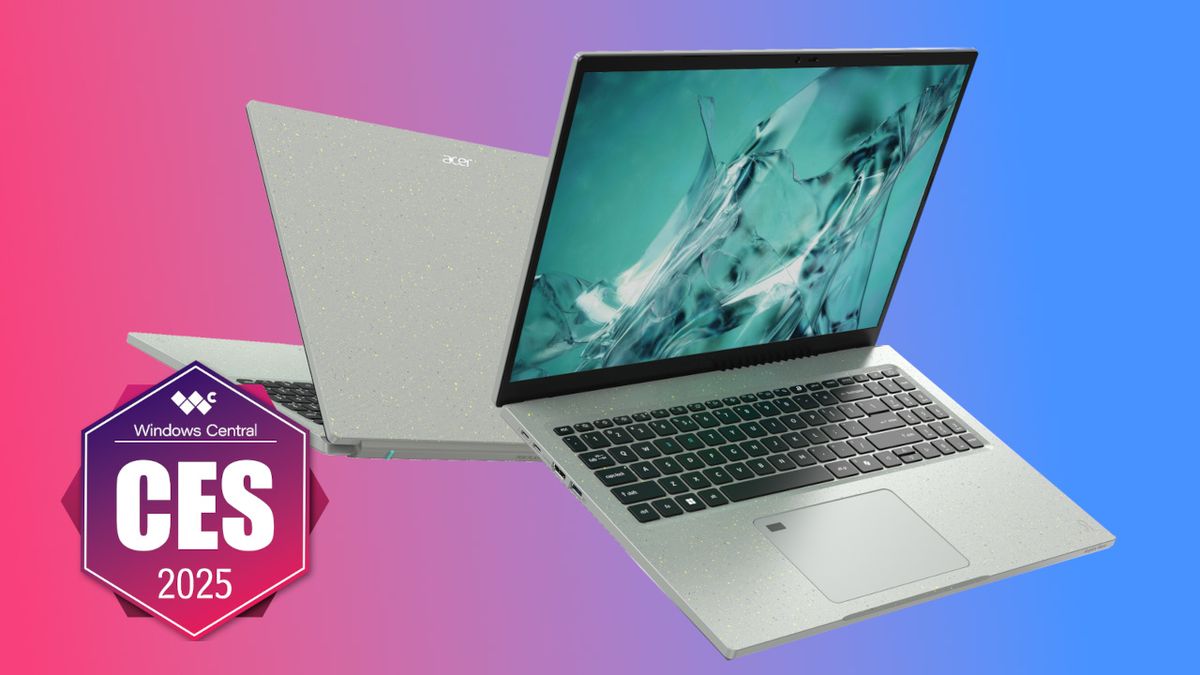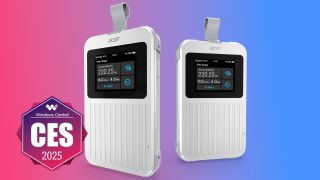
E-waste and the pollution associated with it are massive problems in our modern world. New devices are seemingly always on the way, pushing the previous hardware — often only a couple of years old and in working order — to the side.
The used laptop market, for example, is thriving, but there are still countless devices that end up making their way to a landfill or electronics recycling depots. Plenty of products are shipped around the world where they're stripped and, to the best efforts, recycled. Despite a huge effort, there remains an overabundance of discarded electronics slowly leeching heavy metals into the earth. And that's before we get into all the plastic surrounding the components.
Acer's Aspire Vero 16 is a carbon-neutral AI PC made (partly) from oyster shells



Announced at CES 2025 is the new Aspire Vero 16 (AV16-71P), a laptop that Acer claims will remain carbon neutral throughout its lifecycle. That's a bold claim, and the fine print notes that the lifecycle includes "raw material, manufacture, distribution, use, and disposal."
Acer also states that any "remaining carbon emissions will be offset by high-quality carbon credits to achieve carbon neutrality," which will be verified by a third party. Though the carbon credit system is far from perfect, I don't know of any other laptops that can make the same claims.
OS: Windows 11 Home
CPU: Up to Intel Core Ultra 7 H-series (Series 2)
RAM: Up to 32GB LPDDR5x
Storage: Up to 2TB M.2 PCIe 4.0 NVMe SSD
Display: 16 inches, 1920x1200
Camera: 1440p, privacy shutter
Ports: 2x Thunderbolt 4, HDMI 2.1
Battery: 65Wh
Wireless: Wi-Fi 7, Bluetooth 5.4
Price: From $799.99
Availability: April (NA), Q2 (EMEA)
So, how did Acer do it? The Aspire Vero 16 now uses 70% more post-consumer recycled (PCR) plastic and bio-based oyster shell material in the chassis compared to previous models. Yes, the laptop is at least partly made from oyster shells.
Furthermore, the touchpad uses plastic pulled from the ocean, the overall thickness of unrecycled plastic has been trimmed down, and Acer says it has an "easy-to-repair" design. There's not a lot to go on for that last statement, but I'm envisioning accessible storage and wireless cards, at a minimum. The LPDDR5x RAM won't be upgradeable, but I hope Acer has made it easier to swap out things like the display and keyboard should they be damaged.
Like me, you might be wondering how this laptop holds up under daily use. I won't know for sure until I get my hands on the device for testing, but MIL-STD-810H durability certification sets it up nicely from the start.
Get the Windows Central Newsletter
All the latest news, reviews, and guides for Windows and Xbox diehards.
The Aspire Vero 16 looks like any other modern notebook, save for the flecked finish. Its keyboard includes a number pad, the touchpad has an embedded fingerprint reader, and the QHD webcam in the top bezel includes a privacy shutter.
Inside, the laptop features Intel's new Core Ultra H-series chips from the Series 2 lineup. Acer lists up to a Core Ultra 7, but that's as specific as it gets. The CPU is joined by up to 32GB of LPDDR5X RAM, 2TB of M.2 PCIe 4.0 NVMe SSD storage, and a battery that Acer claims can run for up to 10.5 hours. The 16-inch display has an FHD+ resolution with 100% sRGB color reproduction. Rounding out the specs are dual Thunderbolt 4 ports, HDMI 2.1, and Wi-Fi 7.
The Aspire Vero 16 is expected to launch in North America in April 2025, starting at $799.99.
More new hardware on the way from Acer

The Aspire Vero 16 has piqued my interest the most, but it's far from the only new hardware on the way from Acer in 2025. Also announced at CES 2025 are new Swift Go 14 and 16 laptops powered by Intel's fresh Core Ultra 200H CPUs, 3K OLED displays, Wi-Fi 7, and QHD webcams.
The larger model is expected to launch in North America in April starting at $949.99, while the smaller model should arrive in May starting at $899.99. Here's a brief look at the specs available in the two laptops.
| Specs | Acer Swift Go 14 (SFG14-74) | Acer Swift Go 16 (SFG16-73) |
|---|---|---|
| OS | Windows 11 Home | Windows 11 Home |
| Processor | Up to Intel Core Ultra 9 285H | Up to Intel Core Ultra 9 285H |
| Graphics | Intel Arc (integrated) | Intel Arc (integrated) |
| Memory | Up to 32GB LPDDR5x | Up to 32GB LPDDR5x |
| Storage | Up to 1TB M.2 PCIe 4.0 NVMe SSD | Up to 2TB M,2 PCIe 4.0 NVMe SSD |
| Display | 14 inches, 3K OLED or 2K IPS touch, HDR TrueBlack 500 | 16 inches, 3K OLED or 2K IPS touch, HDR TrueBlack 500 |
| Camera | 1440p, IR HDR, privacy shutter | 1440p, IR HDR, privacy shutter |
| Ports | 2x Thunderbolt 4, HDMI 2.1, microSD card reader, 2x USB-A | 2x Thunderbolt 4, HDMI 2.1, microSD card reader, 2x USB-A |
| Wireless | Wi-Fi 7, Bluetooth 5.4 | Wi-Fi 7, Bluetooth 5.4 |
| Battery | 75Wh | 75Wh |
Also announced are a couple of devices that will make it easier to stay connected when you're on the move.
Acer's Connect M6E 5G mobile Wi-Fi device is small enough that it can fit in your pocket, but it has the power to deliver 5G access for your other Wi-Fi-bound devices. Acer says it can run for up to 28 hours thanks to a built-in battery, outputting a Wi-Fi 6E signal for up to 20 devices at the same time. It's expected to work in more than 135 countries, making it an ideal accessory for mobile professionals. It's expected to launch in Q1 2025 for $249.
The other side of the networking news comes in the form of a Wi-Fi 7 dongle compatible with USB-A and USB-C PCs. Its tri-band setup allows for speeds up to 2,880Mbps; it's expected to launch in Q1 2025, starting at $79.
Be sure to check out my coverage of Acer's new Copilot+ PCs announced at CES 2025, including the sleek Revo Box AI mini PC.

Cale Hunt brings to Windows Central more than eight years of experience writing about laptops, PCs, accessories, games, and beyond. If it runs Windows or in some way complements the hardware, there’s a good chance he knows about it, has written about it, or is already busy testing it.
-
HeyCori I like the idea but I'm still kind of annoyed. Manufacturers never seem brave enough to stick with these concepts long term. How many of these devices will themselves end up as e-waste due to lack of sales? I can't think of a single carbon friendly device that lasted longer than the day it was released.Reply